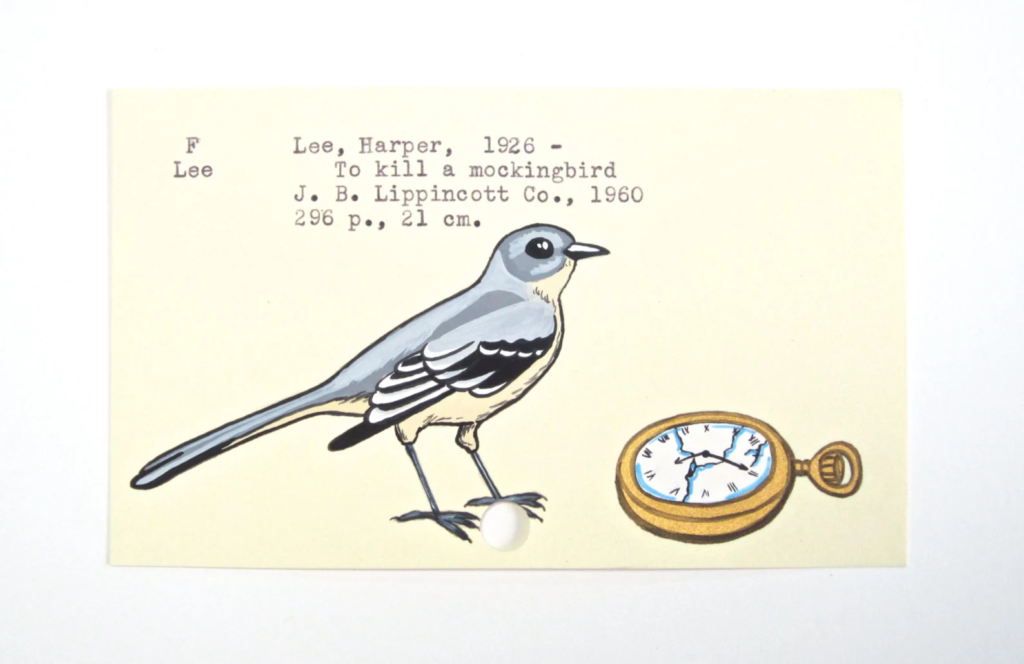by Katharine Elizabeth Monahan Huntley

“I ain’t cynical, Miss Alexandra. Tellin’ the truth’s not cynical, is it?”—Dill The events in Harper Lee’s To Kill A Mockingbird are told from the point of view of six-year-old Scout Finch, as she witnesses the transformations that take place in her small Alabama town during a controversial trial in which her father agrees to defend a black man who is unjustly accused of raping a white woman. The narrative voice, however, is that of a mature woman, looking back on these events from the perspective of adulthood. Her story depicts the gradual moral awakening of the two children as they come to appreciate their father’s courage and integrity in resisting the pressures of small-town bigotry and injustice. They come to realize that things are not always what they seem and that the individual must sometimes be willing to defend unpopular views if he believes that he is doing what is right. (Angyal, 1986, p. 1677) The boy next door to main character Jean Louise (Scout) Finch in Harper Lee’s classic To Kill a Mockingbird is Charles Baker (Dill) Harris—a character based on Harper Lee’s childhood friend, fellow writer Truman Capote. Dill comes to Maycomb each summer to visit his Aunt Stephanie Crawford. Scout describes Dill as “a curiosity . . . his hair was snow white and stuck to his head like duck-fluff; he was a year my senior but I towered over him. . . . We came to know Dill as a pocket Merlin, whose head teemed with eccentric plans, strange longings, and quaint fancies” (Lee, 1960, p. 8). Scout’s impact character, the “Boo” next door, is shy recluse Arthur Radley: “The Radley Place jutted into a sharp curve beyond our house. . . . The house was low, was once white with a deep front porch and green shutters, but had long ago darkened to the colour of the slate-grey yard around it. Rain-rotten shingles drooped over the eaves of the veranda; oak trees kept the sun away. The remains of a picket fence drunkenly guarded the front yard . . .” (Lee, 1960, p. 9). In addition to fulfilling the sidekick role, Dill serves as an echo of Boo’s loneliness: “Why do you reckon Boo Radley’s never run off?” Dill sighed a long sigh and turned away from me. “Maybe he doesn’t have anywhere to run off to . . .” (Lee, 1960, p. 159). Yet unlike Boo, Dill can entertain a hope of escape: “I think I’ll be a clown when I get grown . . . there ain’t one thing in this world I can do about folks except laugh, so I’m gonna join the circus and laugh my head off” (Lee, 1960, p. 238). Atticus Finch, Scout’s father, counsels Scout: “You never really know a man until you stand in his shoes and walk around in them” (Lee, 1960, p. 308). The following Dramatica througline synopsis and act order describes Boo Radley’s storyline, the “mockingbird” in Lee’s masterpiece, where Scout ultimately discovers “. . . just standing on the Radley porch was enough” (Lee, 1960, p. 308). Arthur (Boo) Radley’s Throughline Synopsis As a young boy Boo Radley fell in with the wrong crowd causing his father to shut him away in their home. Boo is not seen or heard again for fifteen years until he coolly stabs his father’s leg with a pair of scissors, causing fresh scandal and contributing to the neighborhood legend of the Radley house of horrors: “You reckon he’s crazy?” Miss Maudie shook her head.” “If he’s not he should be by now. The things that happen to people we really never know. What happens in households behind closed doors, what secrets . . .” (Lee, 1960, p. 51). The children of the neighborhood are equal parts fascinated and terrified of Boo, but as time goes by, they come to realize he is only a gentle soul who has their best interests at heart. “I sometimes felt a twinge of remorse, when passing by the old place, at ever having taken part in what must have been sheer torment to Arthur Radley—what reasonable recluse wants children peeping through his shutters, delivering greetings on the end of a fishing pole, wandering in his collards at night?” (Lee, 1960, p. 267) Throughline as it relates to Manipulation Boo Radley must maneuver within the confines of the way people think about him. Keeping Boo hidden away creates a mystique fueled by ignorance and fear to surround Boo, undermining his efforts to function in the outside world. Concern as it relates to Developing a Plan In order to make friends with the children without frightening them, Boo comes up with the idea of leaving them gifts in a tree. Thematic Issue as it relates to Circumstances Boo Radley is very unhappy with his environment. He is a recluse, and the implication is that is it is not by his own choice. He makes several attempts to alleviate his lonely state by trying to befriend the children. He eventually is able to make a positive impact on the children, Scout in particular; they come to understand he is not a monster, and the circumstances surrounding his life were and are beyond his control. Thematic Issue Counterpoint as it relates to Situation A reasonable evaluation of Maycomb finds Boo Radley as only one of its many eccentrics. Thematic Conflict as it relates to Circumstances vs. Situation Boo’s living situation is desolate, which leaves him emotionally deprived of friendship. Problem as it relates to Desire Boo’s drive to befriend and protect the children is a problem for him because, in the Radley family way of doing things, his older brother wants him to keep to himself. As an example, after discovering Boo has been putting gifts in a tree for Scout and Jem, Nathan Radley fills the knot-hole with cement to stop him from continuing. Solution as it relates to Ability When the children are in danger of being killed, Boo is able to save their lives, which enables him afterward to come forward and meet them, “He turned to me and nodded towards the front door. ‘You’d like to say good night to Jem, wouldn’t you, Mr. Arthur? Come right in'” (Lee, 1960, p. 305). Symptom as it relates to Projection The probability that Scout will never meet Boo is a problem for her, as she will never learn to accept him until she does: “But I still looked for him each time I went by. Maybe someday we would see him . . . It was only a fantasy. We would never see him. He probably did go out when the moon was down and gaze at Miss Stephanie Crawford. I’d have picked somebody else to look at, but that was his business. He would never gaze at us.” (Lee, 1960, p. 267) Response as it relates to Speculation Scout spends a considerable amount of time fantasizing about ever meeting Boo, as she looks for him each time she passes by his house, “‘You aren’t starting that again, are you?’ said Atticus one night, when I expressed a stray desire just to have one good look at Boo Radley before I died. ‘If you are, I’ll tell you right now: stop it'” (Lee, 1960, p. 267). Unique Ability as it relates to Circumstances Boo must carry Jem back to the Finch’s for medical attention. These circumstances result in Scout, in her own home, to literally confront her personal problem—the man she has prejudiced herself against. Critical Flaw as it relates to Senses Boo has been made an invisible being by his family. As no-one can see or hear him, his efforts at making friends are blocked. Benchmark as it relates to Changing One’s Nature As Boo overcomes his shyness toward the children he is able to envision ways to make friends with them. The Impact Character Throughline Act Order: Impact Character Signpost 1 as it relates to Playing a Role Boo Radley appears to the townspeople to be: “. . . a malevolent phantom. People said he existed but Jem and I had never seen him. People said he went out at night when the moon was high, and peeped in windows. When people’s azaleas froze in a cold snap, it was because he had breathed on them. Any stealthy crimes committed in Maycomb were his work.” (Lee, 1960, p. 9) Impact Character Journey 1 from Playing a Role to Changing One’s Nature Boo’s impact on the children changes from them looking t him as being a horror locked away from the light of day to becoming a strange and curious friendly spirit: “‘ . . . he’s crazy, I reckon, like they say, but Atticus, I swear to God he ain’t ever harmed us, he ain’t ever hurt us, he coulda cut my throat from ear to ear that night but he tried to mend my pants instead’. . . It was obvious that he had not followed a word Jem said, for all Atticus said was, ‘You’re right. We’d better keep this and the blanket to ourselves. Some day, maybe, Scout can thank him for covering her up.’ ‘Thank who?’ I asked. ‘Boo Radley. You were so busy looking at the fire you didn’t know it when he put the blanket around you.’ My stomach turned to water and I nearly threw up” (Lee, 1960, pp. 79-80) Once Jem realizes Boo is the one leaving gifts for the children, he is able to overcome his fear of Boo and decides to write him a thank you note to continue this new line of communication, “‘Dear sir,’ said Jem. ‘We appreciate the—no, we appreciate everything which you have put into the tree for us. Your very truly, Jeremy Atticus Finch'” (Lee, 1960, p. 68). Impact Character Signpost 2 as it relates to Changing One’s Nature Although the children still think of Boo as a frightening phantom, his actions have transformed him into more of a friendly ghost than an evil apparition ready to cause harm. Impact Character Journey 2 from Changing One’s Nature to Conceiving an Idea As Boo becomes more human in the children’s eyes, they cannot conceive of why he has remained in what must be a miserable existence: “‘Why do you reckon Boo Radley’s never run off?’ Dill sighed a long sigh and turned away from me. ‘Maybe he doesn’t have anywhere to run off to . . .” (Lee, 1960, p. 159). Impact Character Signpost 3 as it relates to Conceiving an Idea The children spend countless hours devising ways to meet Boo Radley: “Dill had hit upon a fool-proof plan to make Boo Radley come out at no cost to ourselves (place a trail of lemon drops from the back door to the front yard and he’d follow it like an ant).” (Lee, 1960, p. 159) Impact Character Journey 3 from Conceiving an Idea to Developing a Plan Up until Scout and Jem are really in danger, the ideas Boo has come up with to make friends with the children have left his identity ambiguous. Once he sees Bob Ewell terrorizing them, he devises and implements a plan to save them, that in turn reveals to the children he is the man who has watched over them for many years. Impact Character Signpost 4 as it relates to Developing a Plan Boo has the idea “his” children are in danger and comes up with a way to protect them, that ultimately saves their lives. Sources Cited: Angyal, A. J. (1986). To Kill a Mockingbird. In F. N. Magill (Ed.), Masterplots II (pp. 1677-1681). Englewood Cliffs, NJ: Salem Press Lee, H. (1960). To Kill a Mockingbird. London: Mandarin. |
